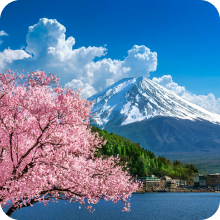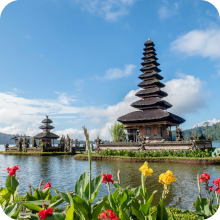Exploring Japan’s Ancient Temples: A Cultural Journey
Japan’s ancient temples are more than just historical landmarks—they are windows into the soul of a nation that has blended spirituality, culture, and natural beauty for centuries. Each temple tells a story, etched into the wood and stone, of a time when the world moved a bit slower and reverence for the divine was woven into everyday life. For travelers eager to experience Japan beyond the neon lights and bustling streets, these temples offer a tranquil retreat into the country's rich past.
Table of Contents
The Historical Significance of Japan’s Temples
The Role of Buddhism in Japan
Buddhism arrived in Japan from China via Korea around the 6th century, and it didn’t take long for it to become deeply intertwined with the country’s culture. Temples began to sprout across the land, serving as centers of learning, spiritual practice, and even political power. These temples, often built in harmony with nature, reflect the core principles of Buddhism—peace, mindfulness, and the impermanence of life.
Temple Architecture
Japanese temples are architectural masterpieces. From the sweeping eaves of pagodas to the intricate carvings of wooden gates, each element is steeped in symbolism. The layout of a temple complex often mirrors Buddhist cosmology, guiding visitors on a spiritual journey as they move through the grounds. Pay attention to details like the stone lanterns, purification fountains, and serene gardens—they are as much a part of the temple’s story as the main hall itself.
Cultural and Spiritual Importance
Beyond their architectural beauty, Japan’s temples are living embodiments of the country’s spiritual heritage. They are places where the past is kept alive through rituals, festivals, and the daily practices of monks and worshippers. Whether you’re seeking spiritual enlightenment or simply a moment of peace, these temples offer a profound connection to Japan’s cultural roots.
Kyoto’s Ancient Temples
Kinkaku-ji (Golden Pavilion)
Few images of Japan are as iconic as the Golden Pavilion of Kinkaku-ji. Covered entirely in gold leaf, this Zen Buddhist temple glimmers in the sunlight, reflected perfectly in the surrounding pond. Originally built in the 14th century as a retirement villa for a shogun, it was later converted into a temple. The harmonious blend of nature and architecture here is a testament to the Japanese concept of wabi-sabi, which finds beauty in imperfection and transience.
Kiyomizu-dera
Perched on the edge of a hill in eastern Kyoto, Kiyomizu-dera is famous for its wooden stage that juts out over the hillside, offering stunning views of the city and surrounding forests. The temple, founded in 778, is dedicated to Kannon, the goddess of mercy, and has long been a place of pilgrimage. Don’t miss the chance to drink from the Otowa Waterfall, whose waters are believed to grant wishes of longevity, success, and love.
Fushimi Inari Shrine
While technically a Shinto shrine, Fushimi Inari is an integral part of Kyoto’s temple landscape. Known for its thousands of red torii gates that form a pathway up the sacred Mount Inari, this site is a stunning blend of spiritual significance and natural beauty. The gates, donated by worshippers, represent wishes for prosperity and good fortune. As you walk through them, you’ll feel as if you’re stepping into another world—one where the sacred and the natural are one and the same.
Nara: The Birthplace of Buddhism in Japan
Tōdai-ji
No visit to Nara is complete without seeing Tōdai-ji, home to the Great Buddha (Daibutsu). This colossal statue, housed in the world’s largest wooden building, is a sight to behold. Constructed in the 8th century, Tōdai-ji played a crucial role in the spread of Buddhism throughout Japan. The temple complex is surrounded by deer, considered sacred messengers of the gods, who roam freely and add to the serene atmosphere.
Hōryū-ji
Hōryū-ji, located just outside Nara, is one of the oldest wooden structures in the world, dating back to the early 7th century. The temple was founded by Prince Shōtoku, a pivotal figure in the early promotion of Buddhism in Japan. Hōryū-ji is a UNESCO World Heritage Site and houses an incredible collection of Buddhist art and artifacts, making it a must-visit for history enthusiasts.
Kasuga Taisha
Kasuga Taisha, a Shinto shrine with deep ties to Nara’s Buddhist temples, is famous for its hundreds of bronze and stone lanterns that line the pathways. The lanterns are lit during the Lantern Festivals in February and August, creating a magical ambiance that transports visitors back to ancient Japan. The shrine’s vermilion buildings stand out against the surrounding forest, symbolizing the connection between the spiritual and natural worlds.
Temples in Tokyo
Senso-ji
Senso-ji, located in the heart of Tokyo’s Asakusa district, is the city’s oldest and most famous temple. Founded in 645, it is dedicated to Kannon, the goddess of mercy. The temple’s grand Kaminarimon gate, with its massive red lantern, is one of Tokyo’s most recognizable landmarks. Senso-ji is a vibrant mix of the old and new, with bustling markets surrounding the temple grounds where you can find traditional snacks, souvenirs, and more.
Zojo-ji
Zojo-ji, a significant temple for the Tokugawa shoguns, is located near Tokyo Tower, creating a striking contrast between the ancient and modern. The temple’s main hall, with its simple yet elegant architecture, is a peaceful retreat in the midst of the city. Zojo-ji is also known for its rows of Jizo statues, which are dedicated to the souls of unborn children and dressed in colorful clothing by grieving parents.
Takaosan Yakuo-in
If you’re up for a bit of hiking, a visit to Takaosan Yakuo-in is well worth the effort. This mountain temple, located on Mount Takao, offers not only spiritual rewards but also stunning views of Tokyo and, on a clear day, Mount Fuji. The temple is dedicated to the Shinto-Buddhist mountain deity Tengu, and the mountain itself is a sacred site. It’s a perfect day trip from Tokyo for those seeking a blend of nature, culture, and spirituality.
Thanks for visiting our blog, are you planing to travel to Japan? Check out our eSIM Japan.

Hidden Gem Temples Across Japan
Ryoan-ji in Kyoto
Ryoan-ji is famous for its Zen rock garden, a masterpiece of simplicity and meditation. The garden’s fifteen stones are arranged in such a way that only fourteen are visible at any given time—a design intended to reflect the imperfection of the world. Visitors often find themselves mesmerized by the serene beauty of the garden, contemplating the mysteries of life as they gaze upon the carefully raked gravel and strategically placed rocks.
Engaku-ji in Kamakura
Engaku-ji, one of the most important Zen temples in Kamakura, is a peaceful retreat from the city’s tourist crowds. Founded in 1282, the temple is part of the Rinzai sect of Zen Buddhism and offers a quiet place for reflection amidst ancient trees and moss-covered stone paths. Engaku-ji is particularly beautiful in the autumn when the leaves turn a fiery red, creating a stunning contrast against the temple’s simple wooden structures.
Sanjusangen-do in Kyoto
Sanjusangen-do is a temple unlike any other, known for its 1,001 statues of Kannon, the goddess of mercy. The statues, arranged in rows inside the temple’s long hall, are a breathtaking sight. Each statue is unique, with intricate details that reflect the skill of the artisans who created them. The temple’s annual archery contest, held every January, is another highlight, drawing participants from all over Japan.
Experiencing Temple Culture in Japan
Participating in Temple Rituals
Visiting a temple in Japan is more than just a sightseeing experience—it’s an opportunity to engage with the spiritual practices that have been part of Japanese life for centuries. Most temples have a purification fountain at the entrance, where visitors are expected to wash their hands and mouth before entering. Once inside, you can light incense, offer prayers, and even join in on chanting or meditation sessions if the temple allows.
Staying at a Temple (Shukubo)
For a truly immersive experience, consider staying overnight at a temple, a practice known as Shukubo. Many temples, especially in regions like Koyasan, offer simple accommodations where guests can experience the daily routines of temple life, including morning prayers, meditation, and vegetarian meals known as shojin ryori. It’s a rare chance to step away from the hustle of modern life and connect with Japan’s spiritual traditions.
Seasonal Temple Festivals
Temples in Japan come alive during seasonal festivals, offering a unique glimpse into local culture and community life. Whether it’s the New Year celebrations at Senso-ji, the Gion Matsuri at Yasaka Shrine in Kyoto, or the Obon Festival honoring ancestors, these events are a vibrant mix of spirituality, tradition, and festivity. Visiting a temple during a festival is a memorable way to experience the living culture of Japan.
Before you take off make sure to check with local government of the travel status.
FAQs
Do I need to follow any specific etiquette when visiting temples in Japan?
Yes, it’s important to show respect by bowing, removing shoes when required, and not disturbing worshippers.
Are there entrance fees for visiting these ancient temples?
Many temples charge a small entrance fee, which helps with maintenance and preservation.
Can I participate in rituals or prayers at these temples?
Visitors are usually welcome to participate in rituals, such as washing hands or lighting incense, but should follow the temple’s guidelines.
When is the best time of year to visit Japan’s temples?
Spring and autumn are ideal due to the pleasant weather and beautiful surroundings, like cherry blossoms or autumn leaves.
Are there guided tours available for these temples?
Yes, many temples offer guided tours in English, or you can join a group tour that includes multiple sites.















